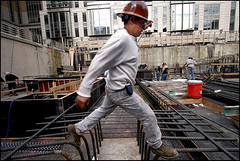Mike Lewyn on the Policy Link Conference in Philly & My response about DC
In the blog Lewyn Addresses America, Mike Lewyn reports on the Policy Link conference on Social Equity that was held last week in Philadelphia.
Mike says this about a presentation about DC, which I respond to below:
There was a session on housing affordability, and a couple of people agreed that developers in the District of Columbia should be weighed down by all sorts of inclusionary zoning and affordable housing requirements. I can understand the logic behind these programs in prosperous cities like San Francisco. But DC is a city that is still losing population and still has a 20% poverty rate- lower than some cities, but higher than the nation and region as a whole (See Census Quick Facts for more information. DC is not in as desperate shape as some cities- but I still think it has a lot more in common with Baltimore or Cleveland than with San Francisco.
________
Thanks for posting this.
I wanted to go to the conference but have been traveling all over lately and I couldn't do it. My joke response to the Pres. of PolicyLink's presentation at last October's National Trust for Historic Preservation annual meeting is that PolicyLink's mission is for "equitable sprawl." (Policy Link does a lot of good work on affordable housing issues and it is an oversight that I don't have a link to them. I will add them to the list at the top of the right sidebar.)
In any case, I think you might be wrong about DC. The residential market is akin to SF, Manhattan and Brooklyn, and Boston. You can't buy houses for less than $200-250,000 now, in most any part of the city, and that price includes shells in Anacostia. Houses in most areas of the NW and NE that are in neighborhoods that can be even seriously problematic such as Trinidad still cost $300,000 or more.
That ain't the case in Cleveland, Baltimore, Detroit, Pittsburgh, or even in the non-Center City part of Philadelphia.
I don't think the Census is correct in claiming DC is continuing to lose population. I just don't see it as new condo buildings sell out before construction is finished and as houses vacant for decades come back online through rehabilitation and sale.
As far as the poverty rate goes, yep, it's there, but concentrated, and people are being pushed out or are doubling up, in order to remain in the city.
This is a huge issue, but it's not just about affordable housing, it's really more about making good jobs available to people with limited educational aspirations.
 Edvin Osorio and other Latinos are part of a historic shift in the demographics of construction workers. (By Michael Robinson-chavez -- The Washington Post). Where are the African-Americans?
Edvin Osorio and other Latinos are part of a historic shift in the demographics of construction workers. (By Michael Robinson-chavez -- The Washington Post). Where are the African-Americans?Today's Washington Post has a page one article, "Hispanics Build a Solid Base: Immigrants Change Makeup of Construction Crews" about how Hispanics have more and more of the construction jobs... In DC, which is one of the strongest real estate markets in the world, it makes no sense in a city with a population of 60% African-Americans to have almost no African-Americans on construction job sites.
(This relates to a project that I am working on that I will write about some time in the future.)



0 Comments:
Post a Comment
<< Home